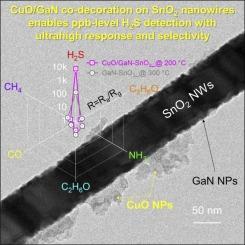超灵敏、选择性CuO/GaN共装饰SnO2纳米线气体传感器,可探测ppb级H2S气体
IF 3.7
1区 化学
Q1 CHEMISTRY, ANALYTICAL
引用次数: 0
摘要
H2S气体具有非常难闻的气味,具有剧毒、易燃和腐蚀性;因此,开发可靠的、高选择性的ppb级敏感H2S气体传感器至关重要。在此,我们通过气-液-固机制获得了SnO2纳米线(NWs),并在其上装饰了GaN纳米颗粒(NPs)。随后,将CuO NPs装饰在gan修饰的SnO2 NWs上。各种表征方法证实了具有NW形态的晶体材料的形成,以及CuO和GaN NPs在SnO2 NWs上均匀分散,具有所需的化学成分。裸SnO2 NW气体传感器在300°C下的响应值为1.35 ~ 10 ppm H2S,而在SnO2 NWs上进行GaN和CuO/GaN共同修饰后,响应值分别增加到37和7268。此外,优化后的气体传感器具有优异的重复性、选择性和长期稳定性。输出量的增加源于CuO向具有高金属电导的cu的转变,GaN和SnO₂之间以及CuO和SnO₂之间形成的界面结影响了电荷输运,以及纳米线结构配置导致了大量丰富的反应位点的可用性。本文章由计算机程序翻译,如有差异,请以英文原文为准。

Ultrasensitive and selective CuO/GaN co-decorated SnO2 nanowire gas sensor with ppb-level detection of H2S gas
H2S gas, which has a highly unpleasant odor, is highly toxic, flammable, and corrosive; hence, development of reliable, highly selective ppb-level sensitive H2S gas sensors is vital. Herein, we obtained SnO2 nanowires (NWs) through a vapor–liquid–solid mechanism and GaN nanoparticles (NPs) were decorated on them. Subsequently, CuO NPs were decorated on the GaN-decorated SnO2 NWs. Various characterization methods confirmed the formation of crystalline materials with NW morphology and the uniform dispersion of CuO and GaN NPs on SnO2 NWs with the desired chemical composition. A bare SnO2 NW gas sensor yielded a low response of 1.35 to 10 ppm H2S at 300°C, whereas after GaN and CuO/GaN co-decoration on SnO2 NWs, the responses increased to 37 and 7268, respectively. Furthermore, the optimal gas sensor yielded excellent repeatability, selectivity, and long-term stability. The enhanced output was stemmed from the transformation of CuO to CuS with high metallic conductance, the interface junctions formed between GaN and SnO₂, and CuO and SnO₂, which affect charge transport, and the availability of numerous abundant reaction sites attributed to the nanowire-based structural configuration.
求助全文
通过发布文献求助,成功后即可免费获取论文全文。
去求助
来源期刊

Sensors and Actuators B: Chemical
工程技术-电化学
CiteScore
14.60
自引率
11.90%
发文量
1776
审稿时长
3.2 months
期刊介绍:
Sensors & Actuators, B: Chemical is an international journal focused on the research and development of chemical transducers. It covers chemical sensors and biosensors, chemical actuators, and analytical microsystems. The journal is interdisciplinary, aiming to publish original works showcasing substantial advancements beyond the current state of the art in these fields, with practical applicability to solving meaningful analytical problems. Review articles are accepted by invitation from an Editor of the journal.
 求助内容:
求助内容: 应助结果提醒方式:
应助结果提醒方式:


